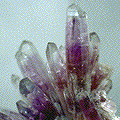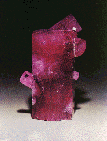"The First Internet Rock Shop!" THE GEMSTONES "The Flowers of the Mineral Kingdom" What makes a gemstone?Generally speaking, a gemstone is a stone that
is beautiful, rare, and durable (resistant to abrasion, fracturing and
chemical reactions). Some minerals can be very beautiful, but they may
be too soft and will scratch easily (such as the mineral
fluorite).
Fluorite is extremely colorful and pretty but has a hardness of only 4 on
the Moh's hardness scale and has four perfect
cleavage directions, which
makes it only an oddity as a cut gem.
Others are too common and are given a semi-precious status (such as
A few gemstones are mineraloids (not true minerals) and are included below: opal, amber, and moldavite. Pearls don't even qualify as mineraloids, as they are not only the result of an organic process plus they are properly composites, containing both the mineral aragonite and the protein conchiolin. While almost any mineral can be cut in the manner of a gemstone, below is a list of some of the gem kingdom's more prized and recognized members. What makes a Precious Metal?Like gemstones, one of the characteristics of a precious metal is its rarity. It could not be "precious" if it were common! Two other characteristics are also important. Foremost is durability - it must not easily corrode away, nor can it be brittle. And that is related to the third characteristic, ductility. This means that the metal must be malleable, that it can be bent, hammered, or otherwise shaped. Gold is the most malleable of metals (it can be hammered into incredibly thin foils or drawn into extremely fine wires), it does not corrode or dissolve except under the most extreme conditions. It is so durable that nearly all of the gold ever mined is still in circulation or storage.
|





















